Content
Stapler
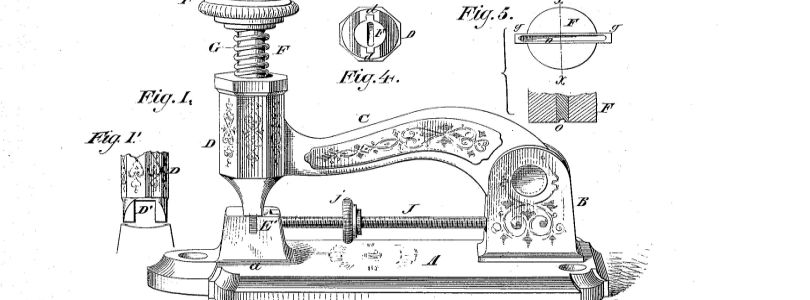
McGill´s "Device for Inserting Metallic Staples in Paper, & c.", 1879 (US 212316A)
The rise and demise of a formerly indispensable office helper
Today we dedicate ourselves to a species threatened with extinction: the stapler. While this device could be found in large numbers for more than a century in all offices around the world, today its habitat is increasingly threatened by digitalization.
The DPMA - a pioneer in electronic data processing among the federal authorities in Germany - has been processing IPR files completely digitally for years. Since electronic invoice processing became standard, too, the staple is gradually threatened with a shadowy existence in office.
McGill, Heyl, Kletzker: The fathers of the stapler
140 years after its emergence, the stapler today seems to lose his dominion over the desks of this world. The "date of birth" of the stapler is considered to be the grant of US Patent No. 212 316 to George W. McGill on 18 February 1879 for his ![]() “Device for Inserting Metallic-Staples in Paper, & c.”. But the history of the stapler, however, is somewhat more complex at second glance. And it had several spiritual fathers.
“Device for Inserting Metallic-Staples in Paper, & c.”. But the history of the stapler, however, is somewhat more complex at second glance. And it had several spiritual fathers.
France's Louis XV is said to have possessed a kind of paper stapler for needles with his royal coat of arms in the middle of the 18th century, but this is not sufficiently proven. One thing is certain: as early as 30 September 1841, Samuel Slocum from Poughkeepsie received a patent for his "Machine for sticking pins into paper" ( ![]() US 2275A), a simple device for attaching paper with needles, which already has several features of modern staplers.
US 2275A), a simple device for attaching paper with needles, which already has several features of modern staplers.
An American Invention
It was not until a quarter of a century later that the New Yorker George W. McGill received the first of several patents that led to an office stapler: US 56587, registered on 24 July 1866, describes a flexible wire staple, the predecessor of the modern staple, and a fastening device (" ![]() Improvements in metallic paper-fasteners"). A year later, on August 13, 1867, McGill received a patent for a "press" that could be used to push the staples into the paper (
Improvements in metallic paper-fasteners"). A year later, on August 13, 1867, McGill received a patent for a "press" that could be used to push the staples into the paper ( ![]() US 67665A, "Press for attaching paper fasteners").
US 67665A, "Press for attaching paper fasteners").
At the same time, other inventors were working on similar devices: The Novelty Mfg Company is said to have registered a paper stapler on August 7, 1866. On 3 November 1868 Albert J. Kletzker from St. Louis received a patent for "Improvement in paper-fasteners" ( ![]() US 83640A). And William J. Brown Jr. patented his "Device for inserting and clinching metallic-staples" (
US 83640A). And William J. Brown Jr. patented his "Device for inserting and clinching metallic-staples" ( ![]() US 218227A) on August 5, 1879.
US 218227A) on August 5, 1879.
Initially only one needle per device
In 1876 McGill showed his original stapler at the world exhibition in Philadelphia, improved it further and finally received the above mentioned patent ![]() US 212316A in 1879. The beautifully designed device became the first commercially successful stapler. However, it weighed more than a kilo and could only attach a single staple at a time, then had to be reloaded.
US 212316A in 1879. The beautifully designed device became the first commercially successful stapler. However, it weighed more than a kilo and could only attach a single staple at a time, then had to be reloaded.
As early as 1877, however, another inventor had applied for a patent for a lighter and more suitable device for everyday use: Henry Renno Heyl (1842-1919) from Philadelphia. Some cineasts and film historians know him as the creator of the phasmatrope. This device was able to project a sequence of still images onto a screen in such a way that they seemed to move and is therefore regarded as a milestone on the way to the invention of cinema.
Controversy among the developers
Heyls stapler, unlike McGill's "Device", allowed the user to insert the staple and push it into paper in one step ("Improvement in devices for inserting metallic staples", ![]() US 195603A). Some therefore regard him as the actual inventor of the stapler.
US 195603A). Some therefore regard him as the actual inventor of the stapler.
In view of the many similar patents coming up within a short period of time, it is not surprising that the various inventors and manufacturers all sued each other towards the end of the 19th century. The first truly "modern" staplers came onto the market only after the First World War.
What do they call the stapler in Japan?
In Japan all staplers are called "hotchkiss". This is because the imported "No. 1 Stapler" from E. H. Hotchkiss Co. in Norwalk was the first stapler of this type on the Japanese market. Hotchkiss therefore became a generic term (e.g. "Tempo" in Germany). This device had a characteristic spiral-shaped "tail" as a clamp magazine. It was patented by James A. Keyes as "Stapling machine" on December 1, 1896 for the Greenfield Automatic Fastener Co. ( ![]() US 572346A). This was taken over by Jones Manufacturing Co., which marketed it as "Star Paper Fastener". Hotchkiss bought the company and made it the "Hotchkiss No. 1." - a worldwide success and perhaps the first "modern" stapler. The company continued to develop its staplers and applied for several new patents (e.g.
US 572346A). This was taken over by Jones Manufacturing Co., which marketed it as "Star Paper Fastener". Hotchkiss bought the company and made it the "Hotchkiss No. 1." - a worldwide success and perhaps the first "modern" stapler. The company continued to develop its staplers and applied for several new patents (e.g. ![]() US 971130A,
US 971130A, ![]() US 1480163A).
US 1480163A).
...and what in Switzerland?
In Switzerland, on the other hand, the staplers are called "Bostitch". Here, too, a company name became a generic term. Thomas Briggs founded the Boston Wire Stitcher Company in Arlington in 1896, which initially concentrated on industrial stitching machines. In 1914, however, the company introduced its first "Portable Stapling Machine" ( ![]() US 1119093A), an invention by Arthur H. Maynard. He continued to work on improvements and registered a new "Stapling Machine" on June 10, 1922 (
US 1119093A), an invention by Arthur H. Maynard. He continued to work on improvements and registered a new "Stapling Machine" on June 10, 1922 ( ![]() US 1506073A). Under the abbreviated company name, this machine came onto the market in 1924 as "Bostitch No. 1" and was the first to use connected staples in a modern style.
US 1506073A). Under the abbreviated company name, this machine came onto the market in 1924 as "Bostitch No. 1" and was the first to use connected staples in a modern style.
Still being improved
The stapler, indispensable for paperwork of all kinds for a long time, is a threatened species today. The variety of subspecies of staples is still enormous - there are many different designs and sizes, e.g. 24/6, 26/6, 26/8, 23/6, 23/8, 23/10 and 23/13 - but the electronic file is increasingly restricting its habitat.
And that's probably a good thing, actually.
But although the stapler is a dying breed, work on optimising it continues to this day - see, for example, "Stapler" ( ![]() EP2240301B1) or the recently granted patent for the "Electric Stapler"
EP2240301B1) or the recently granted patent for the "Electric Stapler" ![]() EP3827927B1 (1,6 MB). Because as long as there is still paperwork on the desks all over the world, there will still be need for stapling!
EP3827927B1 (1,6 MB). Because as long as there is still paperwork on the desks all over the world, there will still be need for stapling!
- You can search for historical and current patents in the DPMA database DEPATISnet.
Text: Dr. Jan Björn Potthast; Pictures: DEPATISnet, Mikebartnz Public domain via Wikimedia Commons, Mikebartnz [Public domain] from Wikimedia Commons
Last updated: 10 December 2025


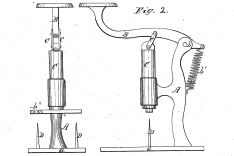
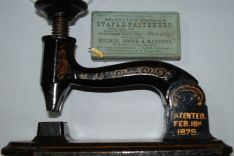
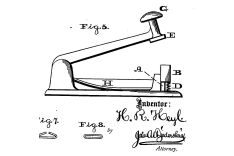
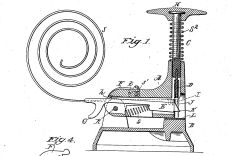
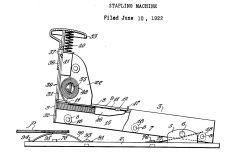
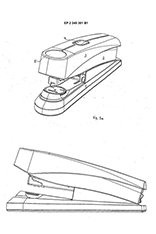
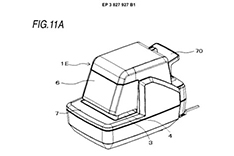
Not only protecting innovations
Social Media